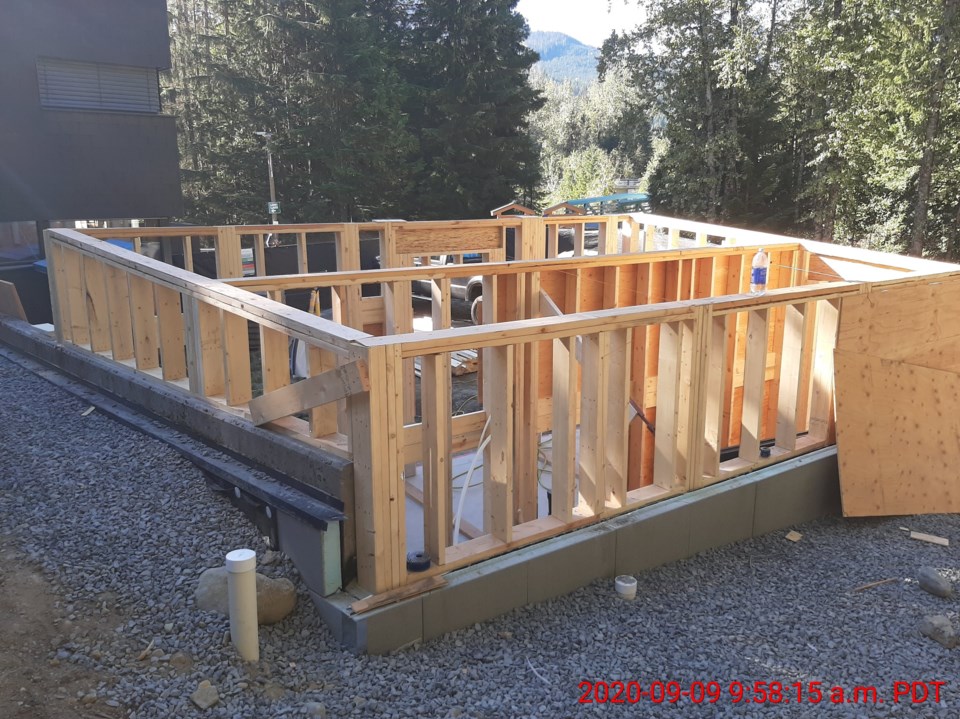The first of three new village washroom facilities—which have stoked concern in the public over the project’s price tag—is expected to open at the Lost Lake Passive House before year’s end.
In a technical briefing on Thursday, Oct. 1, municipal staff provided on update on the project so far, relaying that much of the work being done at both the Passive House and Whistler Olympic Plaza (WOP)—which will be home to the second of three new public washroom facilities, along with the Gateway Loop—has taken place out of the public eye.
“A lot of this work happens below ground and has been backfilled so is not necessarily visible to the public eye when they are looking at the sites there,” noted Melissa Hollis, capital projects supervisor for the Resort Municipality of Whistler (RMOW).
Hollis said “a significant amount of work” has been done at both sites since construction began in May, including laying the foundation, installing interior and exterior concrete walls, and other mechanical work and heat-trace installation.
At the Passive House site, the building frame and roof have been installed, and workers are getting set to install windows and doors before moving to the interior.
In all, the Lost Lake site will house three universal family stalls, while the WOP facility will include 12 stalls in total, including three urinals and two toilet stalls on the men’s side, four toilet stalls for the women’s washroom, and five universal family compartments. Two of the stalls will be designated as accessible.
The work at the WOP site has required “some very deep and complex excavations,” Hollis said. At one point during excavation for a deep manhole and service tie-ins, municipal workers hit a water main connection that has forced the expansion of the project site to accommodate its relocation. Hollis said the tentative completion date for that work and “for the site to return as it was” is the week of Oct. 19.
The village washroom project drew controversy during November’s budgeting process over its $4.5-million cost. Since then, certain design changes were made to help cut costs, most notably replacing the original heavy timber roof with more traditional construction materials.
“The character of the buildings, we tried to still have the wood effect but we’ve reduced it down to a couple of details and the timbers don’t carry through the whole structure,” explained Andy Chalk, the RMOW’s manager of facilities construction.
“The changes in terms of construction details were primarily the result of the cost we received in the first go-around of tendering. We internally didn’t feel those numbers were acceptable and we wanted to revisit the project so we could keep it in the budget we anticipated.”
As it stands, the approved budget is $1.6 million for the WOP facility and $770,000 for the Passive House washrooms, in addition to an estimated $330,000 in so-called “soft costs,” which include consultant and design fees, insurance and project management. The project will be covered in its entirety by Resort Municipality Initiative funding.
Meanwhile, plans to build washrooms at the Gateway Loop—another municipality project that was criticized for its steep price tag—were put off in May as the RMOW amended its budget in light of the COVID-19 pandemic. There is no timeline or final budget for that project’s completion at this point.
Asked if the community’s worry over the project’s final cost was warranted, Chalk said, “those in the construction industry probably have fewer concerns about the cost of things, because, when we build a house, for example, the most expensive components are the kitchen and the bathroom. All we’re building here are bathrooms, so we have very complicated, very cost-intensive components in the buildings, and therefore it drives the price up.”
The RMOW is also exploring the possibility of accessing provincial and federal recovery grants to help offset some of the project’s costs.




